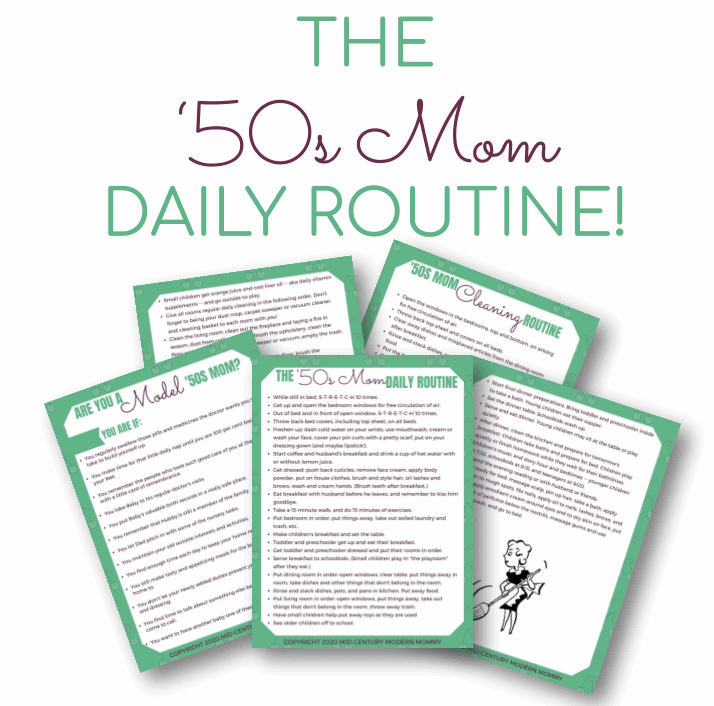Did you know most of the homes in the 1940s and 1950s didn’t decorate in Midcentury Modern style? Actually, most of the homes were fairly traditional in furniture type and decoration — essentially what we are now calling “Grandmillennial” style. Just like the other kinds of housekeeping, decorating had long lists and firm ideas of what was necessary for the “properly furnished living room.” If you’d like to know more about furnishing the perfect living room in the original “Grandmillennial” style, read on to discover how to furnish your living room in genuine 1940s style.

Get Our Mid-Century Mom Daily Routine FREE!
This post contains affiliate links. If you click a link and make a purchase, I may receive, at no additional cost to you, a small commission. Find out more on my Disclosures page, and thank you so much for your support!
First Steps for the Traditional Living Room
The first steps into your home are the hallway and living room. The 1st pillar of being a vintage housewife is to Create a Clean, Comfortable, Company-Ready Home. You will welcome guests to your home if these rooms are attractively decorated. (You will also need to make them comfortable; we will get to that.)
The smaller the room, the more carefully the decor must be considered. This is particularly true when the room is meant for just passing through, like an entry hall. Proportion, color, and balance will be especially important.
Your living room will complete the greeting begun to your guests by the hall. Your living room should create a sense of comfort, and not seem cheap and gaudy. The fabrics should be sturdy and be able to take plenty of wear from children and pets.
If your living room is mostly for family use, it should be more calming, with a subtle, softer color scheme — a place that inspires rest. If the room is mostly for entertaining company, it can be more interesting and stimulating. When your living room is a multi-purpose room, try to lean more toward creating a sanctuary for your family.
Furniture for the Traditional Living Room
Essentials for the Entry
Even the smallest of hall-entries need the following items. However, if your hall is a large reception-hall-style entry, you may want to add an extra sitting area, using the same list of furniture as for the living room, and make it a company sitting area for greeting unexpected guests.
Console Table
A vintage console table was not just used for tossing the keys and the mail down. It usually had drawers which held extra lipstick, face powder, pins, and even perfume for the lady of the house when she needed to leave in a hurry. It usually had a mirror hung above it and a hat rack or hall tree nearby, so that the gentleman could hang their hats and then take them as they walked out.
Wall Mirror
The vintage hall ALWAYS had a mirror above the hall table. Every woman checked her hair and makeup on the way out, while putting on gloves, hat, and coat. Every gentleman did the same — not the makeup tho. And the mirror needed to have a lamp on either side.
Side Chairs
If your hall was VERY tiny, just a single side chair that could be easily moved would be used. But 2 or 3 side chairs were preferred — at least 1 on each side of the console table.
HaT Rack and Umbrella Stand
A vintage entry needed either a freestanding hatrack and umbrella stand or a hall tree up against the wall, which combined a place to sit with a place to hang your hat.
Some of the most AMAZING hall trees combined mirror, console, small bench seats, and hat hooks. Mostly these types of hall trees were built into the wall, but they were a remarkable way to ensure that a small entry had all the necessary equipment! However, they were also considered very (very) old-fashioned.
Nice to add In The Entry
Plants
A very traditional decoration for the hall is a pair of small topiary-trained bay trees in large matching pots to stand on either side of the door.
Telephone Table
A vintage house usually had the telephone in the front hall, with a telephone table and bench. A message pad and writing supplies were kept there also. I love this idea because even people with cell phones may want to go somewhere to take an important call.
Coat Closet
This should be obvious but if you live in a temperate climate, you will need somewhere for your family and your guests to hang heavy wraps. If you don’t have a closet in the hall, you will need to assign a spot SOMEWHERE in the house for this.
Credenza, Armoire, or Chest
A large, freestanding cabinet, such as a repurposed buffet or wardrobe that can store various items and display accessories, is always nice! Even a bookcase, used for display, or old Victorian whatnot can work really well here, depending on the style of the room.
Accessories
In the hall, accessories are usually lamps, figurines, and possibly vases. You may also choose to include soft furnishings, like rugs, draperies, and portieres, as accessories, to unify your decorating for this room. In such a small room, even design choices like wallpaper or paint become an accessory. If you plan to have pictures on the wall, don’t forget that frames are also an accessory, just like the picture itself!
Essentials for the Living Room
Most of these essentials also apply to a family room or den, and a library or study. In my vintage housekeeping books, these are called 2nd living rooms, along with living porches, and are treated the same way in cleaning and organizing.
Couch or Sofa
The first items that you need in a traditional living room are seating and surfaces. A couch, sofa, or sectional pieces that form a couch, large enough to seat guests. As you gain children, you’ll need to add another couch or sofa as well. The rule of thumb in my vintage books is 1 couch per 4 people in the household — if you have the 2 upholstered chairs for the man and woman of the house (which we will talk about next!).
2 or 3 Comfortable Chairs
1 of these chairs should be a masculine, comfortable style — I like to suggest that this is the recliner for the breadwinner to relax in!
Another chair should be a chair JUST FOR YOU. This is a hard thing for a lot of housewives. We are pretty good at making sure that the children respect “Papa’s Chair,” but we don’t make the same consideration for ourselves. AND WE SHOULD.
This one thing is definitely part of putting your marriage first. You are part of the marriage. You do the work of homemaking in this relationship. The breadwinner deserves a chair for his contribution, supporting the household and the family. YOU deserve a chair for your contribution — managing the household and the family. Your children SHOULD NOT GET TO TAKE OVER YOUR CHAIR OR HIS! (Rant over.)
The last chair should be a comfortable upholstered chair that can be used as an extra reading chair or for overnight night guests.
2 or 4 side chairs
These should be smaller, less-important upholstered chairs that can be put around a game table — we will talk about a game table a little later. They should be comfortable and easy to move.
Desk
Every house needs a desk. And often more than one. The living room desk should contain house stationery, writing equipment, and a few good, basic reference books: Webster’s Dictionary, The New York Public Library Desk Reference, Roget’s Thesaurus, a good Home Health Reference, and a good household encyclopedia should cover everything that you need right there. (It probably shouldn’t be your home management desk, though!)
Game Table
This can also just be a large table, like a library table, but an extra surface where children can do a holiday craft, where a living room buffet can be set out, or even just to play a game together on, is really important.
End Tables
These small tables should be able to hold an ashtray, a lamp, and a book or two. Obviously, you will want to keep the tables clear, except for lamps, but this will give you a good idea of a size that won’t seem too delicate and spindly. All of these lamp tables should be at least 2 feet across.
Coffee table
A reasonably large coffee table will help you pull together a conversational seating area in your living room. It’s also a good place to display special accessories or beautiful books.
Bookcases and Cabinets
Your bookshelves can also be for displaying accessories. Your cabinets should provide enough storage for odds and ends that the living room can be kept and look neat and tidy. If you only have a single living room for the whole family to do their living in, you’ll need a few bookshelves for all the family’s books, a large armoire or a low credenza to keep the children’s toys and art or hobby supplies, and a cabinet to house entertaining needs.
Nice to Add In The Living Room
Radio, Record Player, and Televsion
All of this equipment will need a cabinet of its own. A low credenza or vintage hi-fi/AV console is perfect. Modern TVs can now be framed and put on the wall, which makes all my Mr. Roger’s Picture-Picture dreams come true!
Accessories
Accessories for the living room include wall mirrors, table and floor lamps, a clock, art (pictures and figurines), bric-a-brac (which can also be art! Antique Asian vases, anyone?), plants, fireplace fittings, ashtrays — really anything that makes your living space serve you and your family better. I include lots of throws and pillows and baskets for putting toys away (currently our living room corner functions as the “playroom”). Also, you’ll want to consider color, especially as it ties wallpaper or paint, rug, draperies, and upholstery.
And that is the basics of how to furnish your home. Don’t forget to have a theme (like Georgian or Colonial) and a color scheme for your decorating plan before you buy anything. It’s also a good idea to make a floor plan so you can look at how the furniture will fit, and take notes of room measurements with you when you shop for furniture.
Don’t forget to tell me in the comments whether you prefer mid-century traditional or mid-century modern home style in the comments?



